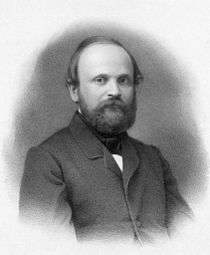Robert Remak
- For the mathematician, Robert Remak (mathematician)
| Robert Remak | |
|---|---|
 | |
| Born |
26 July 1815 Posen |
| Died |
29 August 1868 (aged 53) Bad Kissingen |
| Nationality | Polish/German |
| Fields |
Embryology Physiology Neurology |
| Alma mater | University of Berlin |
| Doctoral advisor |
Ferdinand Georg Frobenius Hermann Amandus Schwarz |
| Known for | kemoderm, mesoderm and endoderm |
Robert Remak (26 July 1815 – 29 August 1865) was a Polish/German embryologist, physiologist, and neurologist, born in Posen, Prussia. Dr. Remak obtained his medical degree from Friedrich Wilhelm University in Berlin in 1838 specializing in neurology.[1] He is best known for reducing Karl Ernst von Baer's four germ layers to three: the ectoderm, mesoderm, and endoderm. He also discovered unmyelinated nerve fibres and the nerve cells in the heart sometimes called Remak's ganglia. He studied under Johannes Muller at the University of Berlin.
Remak discovered that the origin of cells was by the division of pre-existing cells.[2]
Despite his accomplishments, because of his Jewish faith, he was repeatedly denied full professor status until late in life, and even then was denied the usual benefits of the position. According to historian Paul Weindling, Rudolf Virchow, one of the founders of modern cell theory, plagiarized the notion that all cells come from pre-existing cells from Remak.[3]
His son Ernst Julius Remak was also a neurologist and his grandson was the mathematician Robert Remak who died in Auschwitz in 1942.
References
- ↑ Kish, B. 1954. Forgotten leaders in modern medicine: Valentin, Gruby, Remak, Auerbach. Transactions of the American Philosophical Society. 44, Issue 2, 139–317.
- ↑ Magner, Lois N. A history of the life sciences. p185
- ↑ Silver, George A. (January 1987). "Virchow, the heroic model in medicine: health policy by accolade". American Journal of Public Health. 77 (1): 86. doi:10.2105/AJPH.77.1.82. PMC 1646803
 . PMID 3538915.
. PMID 3538915.
- Schmiedebach, H P (1990), "Robert Remak (1815–1865). A Jewish physician and researcher between recognition and rejection", Zeitschrift für ärztliche Fortbildung, 84 (17), pp. 889–94, PMID 2251855
- Anderson, C T (1986), "Robert Remak and the multinucleated cell: eliminating a barrier to the acceptance of cell division.", Bulletin of the history of medicine, 60 (4), pp. 523–43, PMID 3545332
- Seeliger, H P (1985), "The discovery of Achorion schoenleinii. Facts and stories (Johann Lucas Schoenlein and Robert Remak).", Mykosen (published Apr 1985), 28 (4), pp. 161–82, PMID 3889638
- Schwann, J; Schwann, S (1963), "Circimstances of the Discovery of the Pathogen of Favus (Trichophyton Schoenleini, Achorion Schoenleini) by Robert Remark", Annales Academiae Medicae Stetinensis, 9, pp. 161–7, PMID 14059131
External links
- Biography
- Scientific biography
- Short biography and bibliography in the Virtual Laboratory of the Max Planck Institute for the History of Science